Are you mindful of the crucial role cooking oil plays in your daily diet? As a staple ingredient in every household, the choice of oil can significantly impact your overall health.
In a world flooded with various cooking oil options, it is natural to feel overwhelmed and uncertain about which is best for your well-being.
But fear not!
In this blog, we will delve into the diverse world of cooking oils, examining their health implications and guiding you towards the optimal choice for you.
As you continue reading, you’ll gain insights into the distinct characteristics of various cooking oils, understanding how they contribute to your overall health. This literature will empower you with the knowledge to make informed decisions about the oils you use daily for a healthier lifestyle.
Let’s dive into the world of oils together and make a positive change that resonates with every meal you prepare.
Table of Contents
What is the Importance of a Good Cooking Oil?
Selecting a good cooking oil is essential as it can contribute essential nutrients and healthy fats to your diet, such as monounsaturated or polyunsaturated fats, while minimizing unhealthy saturated or trans fats.
Edible oils impact your cardiovascular health and weight. Making informed choices about the cooking oils you use is an essential aspect of maintaining a balanced and health-conscious lifestyle.
What is Smoke Point and Why is it Important?
The smoke point is the temperature at which an oil or fat begins to break down and produce visible smoke. It is an important consideration in cooking because when an oil reaches its smoke point, it can impart undesirable flavours and aromas to the food.
Heating oils beyond their smoke points can lead to the formation of harmful compounds, such as free radicals and trans fats. These compounds can have negative health effects when consumed regularly.
Oils with higher smoke points are better suited for high-temperature cooking methods such as frying.
Oils either contain saturated fats, monounsaturated fats (MUFA), polyunsaturated fats (PUFA) or a combination of these.
MUFA and saturated fats are heat resistant whereas PUFA are sensitive to high heat.
Additionally, oils have the tendency to go rancid.
Rancidity causes the breakdown of fats and they undergo oxidative damage on exposure to air, heat or light. This results in a decline in the nutritional value and production of various foul-smelling compounds, linked to various health issues, including inflammation and chronic diseases.
Saturated fats and MUFA are resistant to oxidative damage while PUFA are susceptible to oxidation.
So, next time you find any food or packaged product with foul-smelling oil, do not consume it.
Types of Cooking Oil
Cooking oils typically differ in aspects, including their source, composition, flavour, smoke point, and nutritional properties. In this section, we will cover all the aspects of the top 9 cooking oils in India commonly available and used in our households.
Olive Oil for Cooking
Olive oil is obtained from olives, the fruit of the olive tree (Olea europaea). It is a key component of the Mediterranean diet and is renowned for its health benefits and versatile culinary applications. Olive oil is primarily composed of monounsaturated fats, along with various antioxidants and vitamins.
You will find various types of olive oil in the market that vary based on flavour, processing methods and acidity.
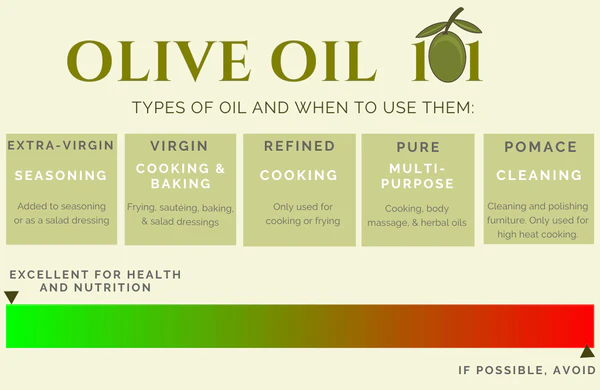
Olive oil is primarily composed of oleic acid (around 80%) which is a monounsaturated fatty acid with incredible health benefits. It also contains various plant polyphenols like oleocanthal, carotenes, etc. with potent anti-inflammatory and neurological-protective properties1.
It is a good source of vitamin E – a powerful antioxidant.
Studies have associated the intake of extra virgin olive oil with a reduced risk of cardiovascular diseases2, metabolic disorders like type 2 diabetes and inflammatory conditions.
The smoke point of olive oil is generally considered between 190-207°C (374-405°F) making it safe for cooking.
P.S. While opting for an olive oil, consider Extra Virgin Olive Oil or Virgin Olive Oil.
Avocado Oil for Cooking
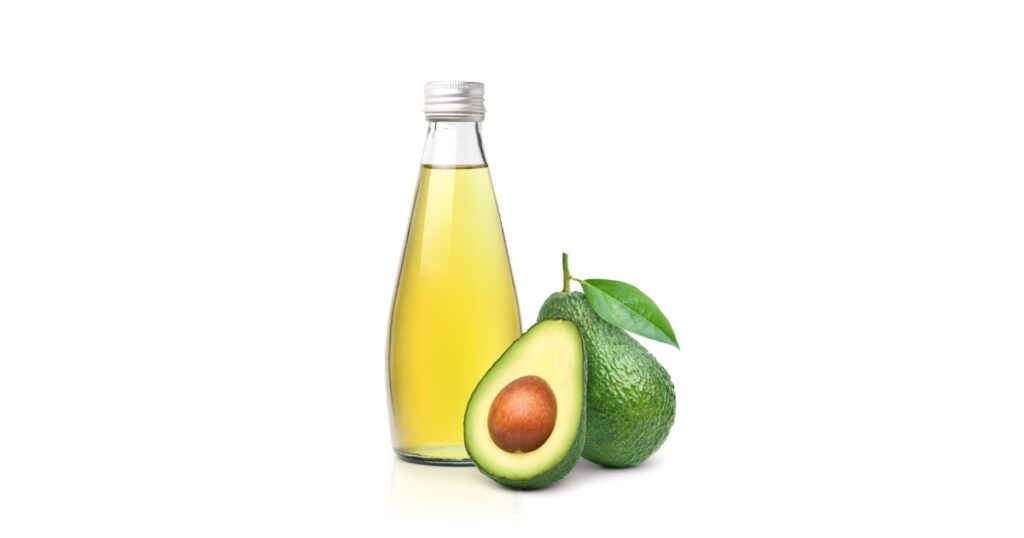
Another type of cooking oil that has recently gained popularity owing to its impressive nutritional attributes.
Avocado is a fruit and its pulp is majorly composed of about 60% oil with 7% skin, and 2% seed. The reason why many health experts have started recommending avocado oil is because of its high MUFA and less PUFA and saturated fat content.
It is packed with antioxidants, healthy fat (oleic acid), has a thermal stability like olive oil and resistant to oxidation3.
Studies support the association of regular intake of Avocado or Avocado oil with a lower of coronary artery diseases and blood pressure.4 5
P.S. Be cautious while selecting avocado oil as several studies suggest that most of the avocado oils sold in the market are either rancid or adulterated with other cheap oils.
Coconut Oil for Cooking

One of the most controversial oil – coconut oil.
A few experts question its health effects because of the high saturated fat content.
Coconut oil has a distinct fatty acid profile compared to other oils. It contains around 90% saturated fat, making it heat resistant and excellent for high-heat cooking methods like frying.
Coconut oil is an excellent source of medium-chain fats or MCTs. These are healthy fats, easy to digest and may help you lose weight by suppressing the appetite. Medically, MCT fats have been shown to be benefit people suffering from epilepsy, diabetes and brain diseases.
Many fitness enthusiasts, bodybuilders and people on ketogenic diets also consume coconut oil to enjoy the benefits of MCT fats.
Another unique fatty acid in coconut oil is Lauric acid. Lauric acid has potent antimicrobial properties and has been shown to boost HDL (good cholesterol) levels.
Despite its high saturated fat content, there are no conclusive studies proving that coconut oil intake increases harmful LDL cholesterol levels and cardiovascular disease risk.
Coconut oil is a staple in Southern India and across many parts of the world, however, the incidence of heart diseases is not necessarily due to coconut oil intake. Other factors like lifestyle, dietary choices and physical activity level also matter.
P.S. Though coconut oil helps boost metabolism, it is high in calories. Excess intake may increase your calorie load more than the daily requirement. Therefore, moderation is the key to enjoying coconut oil benefits.
Mustard Oil for Cooking
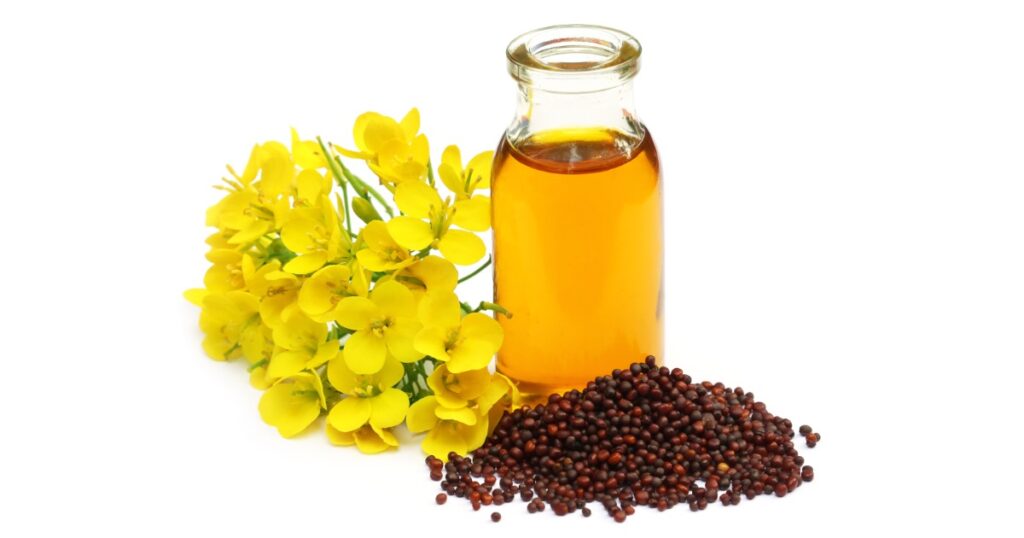
Mustard oil is one of the most commonly used oils in Indian households. It is extracted from mustard seeds and has a reddish brown colour and strong flavour.
This oil is known for various health-boosting effects. It has anti-microbial and antioxidant properties and support healthy skin and hair.
Mustard oil contains a compound called allyl isothiocyanate, which is believed to relieve pain and inflammation. It also comprises of micronutrients like vitamin E, calcium, selenium, magnesium, and vitamin A6.
It has a high smoke point and can be used for high-heat cooking methods like frying and grilling. Mustard oil is majorly composed of heart-healthy MUFA fats like oleic acid with some percentage of PUFA.
A few animal studies have linked the intake of mustard oil with heart and liver-related disorders due to the high concentration of erucic acid, which is a monounsaturated fatty acid. Due to this reason, pure mustard oil is banned in some countries7.
However, there are no human studies or trials to support this claim and various studies have shown no toxic effects of mustard oil on humans.
P.S. If you enjoy the flavour and are comfortable with its use, you can incorporate mustard oil into your cooking. However, it is advisable to use cold-pressed or kachi ghani mustard oil to enjoy the benefits.
Peanut Oil for Cooking
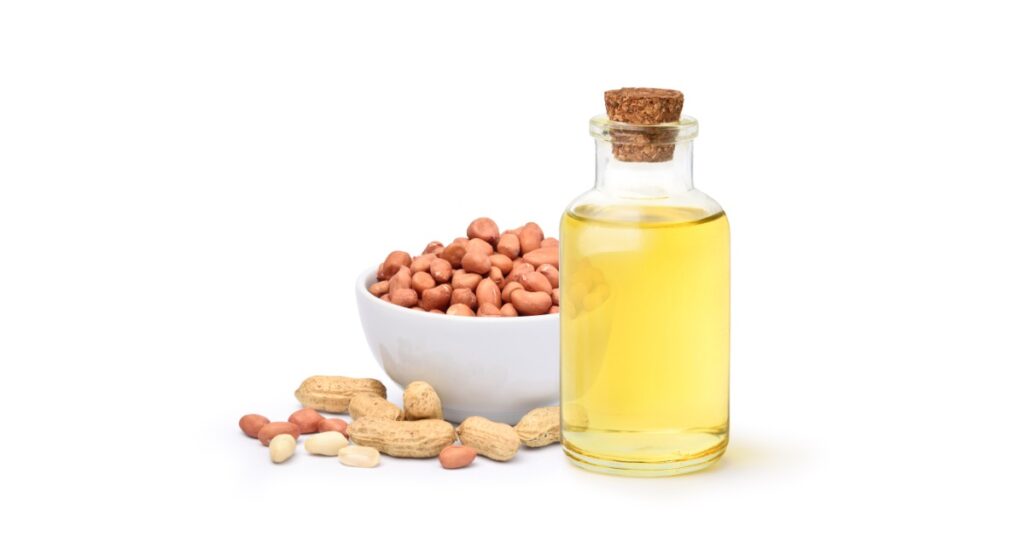
Peanut oil or groundnut oil is extracted from peanuts. This edible oil is also widely used for high-heat cooking due to its high smoke point.
It also contains a good concentration of oleic acid and vitamin E which keeps our heart and cholesterol levels healthy. However, it also has high omega-6 fatty acid content8.
Excess omega-6 intake is not considered good for health and may cause metabolic disorders and inflammation. Since peanut oil is a blend of MUFA and PUFA fats, it is prone to oxidation.
P.S. If you like nutty flavour of peanut oil, prefer cold-pressed unrefined oil. Use it in moderation as excess intake may disrupt the omega 3:6 ratio in the body, increasing the risk of inflammation.
Sesame Oil for Cooking
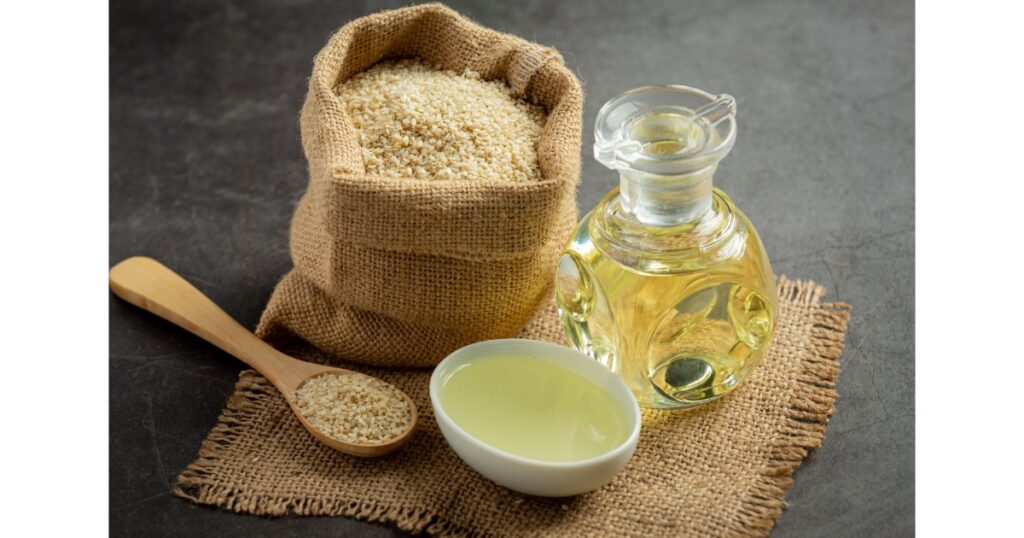
Extracted from sesame seeds, sesame oil is a powerhouse of two potent antioxidants – sesamol and sesaminol. These two protect our organs from oxidative stress and inflammatory markers9.
People with joint pain and arthritis often use sesame oil topically for massaging to ease stiffness and pain.
Various studies have observed that sesamin has potent lipid-lowering properties. It may decrease cholesterol synthesis and boost good cholesterol levels in the body. Additionally, it can also help minimize the hyperglycemic effect and support healthy blood sugar levels.
Sesame oil is around 80% unsaturated fatty acid. It can undergo oxidation, especially if exposed to light, heat, or air, which may affect its flavour and nutritional quality.
P.S. Impurities, such as water or leftover particles from sesame seeds, can promote oxidation. It is essential to choose high-quality, filtered sesame oil to minimize impurities.
Sunflower Oil for Cooking
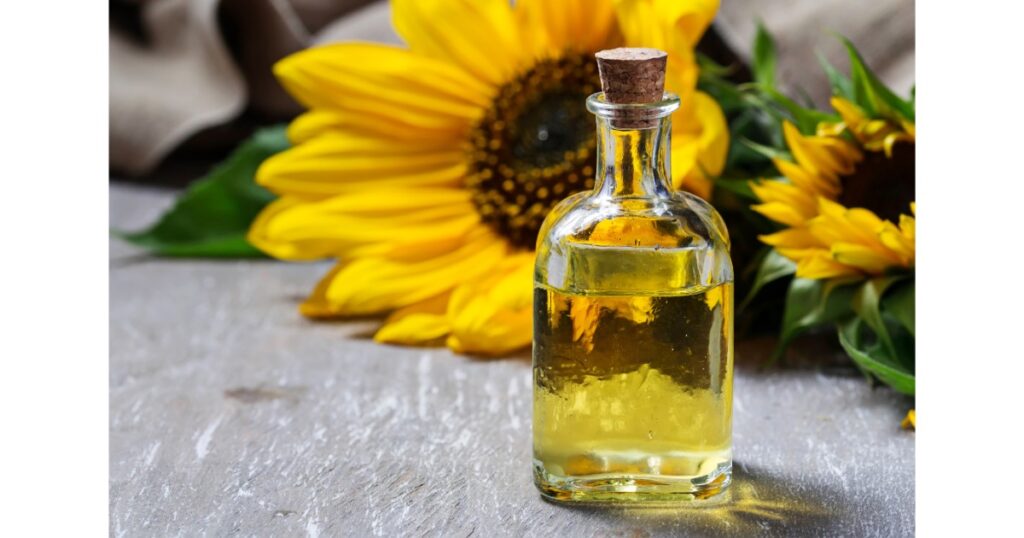
Sunflower oil is one of the most widely consumed edible oils globally. It has a neutral flavour, is easily available, affordable and has a longer shelf life compared to other oils.
It is extracted from sunflower seeds and is considered good for health due to its low saturated fat, high unsaturated fat and vitamin E content.
Sunflower oil is rich in linoleic acid which is an essential omega-6 PUFA. It helps keep cholesterol level in control and prevent harmful LDL cholesterol from accumulating in the body10.
Refined sunflower oil has a high smoke point, typically around 227°C (440°F ). This makes it suitable for various cooking methods, including frying and sautéing.
Before you decide to make it a staple, it is important to know that even though sunflower oil contains an essential omega-6 fat, excess consumption may cause adverse effects. High levels of omega-6 in the body are linked with increased inflammation, diabetes and other health issues. Therefore, moderation is the key.
Repeated use of the same oil at high temperatures may cause the production of harmful compounds and might be dangerous to health.
P.S. Avoid over usage of sunflower oil due to its high omega-6 content. Prefer unrefined sunflower oil variety with high oleic acid content instead of linoleic acid.
Canola Oil for Cooking

Canola oil is a type of vegetable oil derived from the seeds of the canola plant (Brassica napus or Brassica rapa).
It is highly refined and processed oil and the crops are mostly GMO (Genetically Modified Organism).
Canola oil is a good source of omega-3 (alpha-linolenic acid) and omega-6 (linoleic acid) fats. It also contains vitamins E and K11. Even though canola oil has been shown to exhibit cardio-protective effects and may help improve insulin sensitivity, excess intake can harm health and cause inflammation in the body.
Canola oil has a light flavour and a high smoke point, making it suitable for various cooking methods such as frying, sautéing, baking, and salad dressings.
P.S. Canola oil is highly processed and refined oil. Avoid using it and choose other better alternatives like extra virgin olive oil.
Palm Oil for Cooking
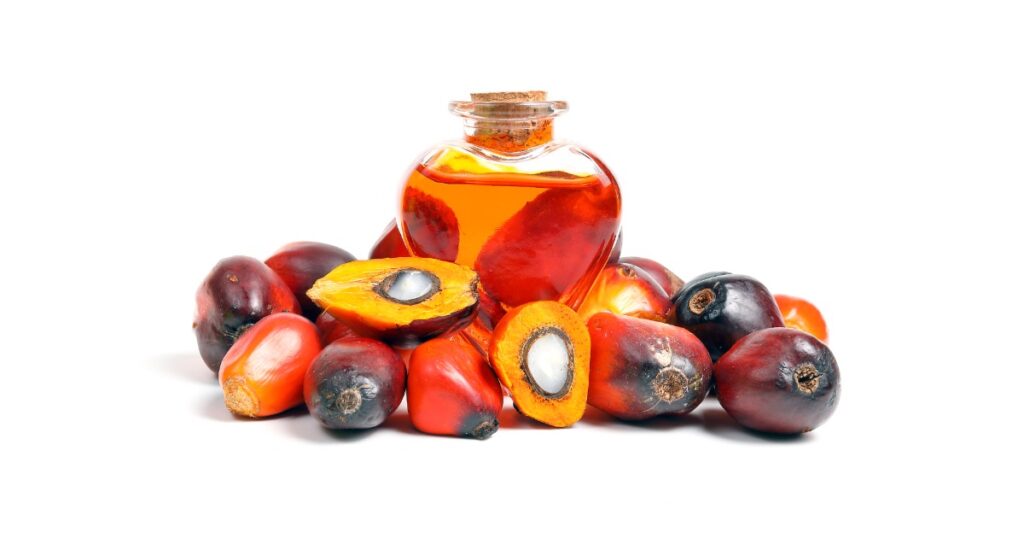
Palm oil is a significant contributor to the oils and fat market worldwide; around 85% is used in food applications. It is extracted from the fruit of palm tree and its unrefined form is reddish-orange in colour.
Palm oil is least expensive, widely available and a part of most of the packaged foods.
Develop a habit of reading the ingredients list before buying any packaged or processed food. You will palm oil listed in many foods like chips, cakes, ice creams, cookies, biscuits, and many more.
Palm oil contains around 50% of saturated fats, 40% MUFA and 10% PUFA. Its high saturated fat content makes palm oil resistant to oxidation. This stability enhances the shelf life of products that contain palm oil, reducing the need for artificial preservatives12.
The red-orange colour of the unrefined palm oil is due to the presence of antioxidants called beta-carotene (vitamin A). Some studies suggest that this antioxidant content may help minimize heart and brain disease risk and help maintain vitamin A levels in our body.
Palm oil has always been in controversies. It has been associated with various environmental concerns. Large-scale palm oil plantations often contribute to deforestation. Deforestation associated with palm oil cultivation releases large amounts of stored carbon dioxide into the atmosphere, contributing to climate change. The use of pesticides and fertilizers in palm oil plantations can lead to pollution of air and water sources.
Efforts are being made to address the negative environmental and social impacts associated with palm oil production through sustainable practices.
P.S. Palm oil is the most widely used refined oil. However, its cultivation may pose threat to our enviornment. Avoid using it and choose other better alternatives like extra virgin olive oil.
Can Cooking Oil Cause Inflammation?
Certain cooking oils, especially those high in omega-6 fatty acids, have been associated with inflammation when consumed in excess.
Our bodies need a balance of omega-3 and omega-6 fatty acids for optimal health, but looking at the current dietary patterns, there is an overabundance of omega-6 fatty acids, which can contribute to an inflammatory response.
This is because most of the households use refined oil for cooking, frying, baking, etc. Additionally, refined oils are also a part of packaged, processed and junk foods.
This collectively increases the ratio of omega-6 fats in the body, resulting in inflammatory conditions, joint pain, knee pain, diabetes, and cardiovascular disorders.
Which Cooking Oil is Good for Health?
In the diverse landscape of cooking oils available in the market, making a health-conscious choice is essential.
While numerous oils offer advantages, it is crucial to be mindful of potential disadvantages associated with refined, processed oils with high omega-6 content.
Based on above mentioned scientific evidence and nutritional profile, extra-virgin olive oil & mustard oil are the best cooking oils and emerge as a highly recommended option.
Olive oil is rich in monounsaturated fats, which are considered heart-healthy and have been associated with various health benefits. It is a source of antioxidants, including vitamin E and polyphenols, which can help combat oxidative stress in the body. Additionally, olive oil has anti-inflammatory properties and may contribute to better cardiovascular health.
Mustard oil offers a range of health benefits due to its high content of monounsaturated fats and antioxidants. It is known to improve heart health, aid digestion, and promote skin and hair health when used both topically and in cooking.
One can enjoy both culinary versatility and potential health advantages by choosing cold-pressed olive oil and mustard oil for cooking.
Final Verdict
While extra-virgin olive oil stands out as an excellent choice for its numerous health benefits, another important type of fat that should be a part of your diet is Ghee (clarified butter).
Ghee, a form of clarified butter widely used in traditional cuisines, offers distinct advantages. Ghee has a high smoke point, making it suitable for various cooking methods, including sautéing and frying, without breaking down into harmful byproducts.
Unlike some vegetable oils, ghee is resistant to oxidation due to its saturated fat content, which contributes to its stability at high temperatures. Rich in fat-soluble vitamins like A, E, and D, ghee supports overall health and may aid in nutrient absorption. Its fatty acid profile includes a mix of saturated, monounsaturated, and polyunsaturated fats, promoting a balanced intake.
Ghee has been used in traditional practices for centuries, and its potential benefits include improved digestion, support for a healthy gut, and anti-inflammatory properties. However, moderation is key, as ghee is calorie-dense.
Embracing a combination of olive oil, mustard oil and ghee in your culinary preparations allows you to enjoy the unique advantages each offers, providing a well-rounded approach to cooking oil for a health-conscious lifestyle.
Frequently Asked Questions
Which is the best olive oil for cooking in India?
There are several good-quality extra-virgin olive oil and mustard oil brands available in the market. You can choose any provided the oil is cold-pressed and free from additives.
Which cooking oil is good for health?
You can consider extra-virgin olive oil, ghee and mustard oil.
Which is the best cooking oil for heart?
Extra-virgin olive oil has been shown as one of the best oils to keep your heart healthy because of its high oleic acid and vitamin E content.
What are the benefits of cooking with coconut oil?
Cooking with coconut oil offers a high smoke point, making it suitable for various cooking methods. Coconut oil contains medium-chain triglycerides, believed to provide quick energy. Some studies suggest potential benefits for cholesterol levels and antioxidants. Additionally, it is a stable fat at room temperature and is popular for its skincare and haircare applications. However, moderation is advised due to its saturated fat content.
Which oil is best for Indian cooking?
You can consider ghee, mustard oil and olive oil.
Which cooking oil is good for health in India?
There are various types of oils in India but you should prefer using ghee, olive oil and mustard oil.
Can we use parachute coconut oil for cooking?
Parachute is a brand known for producing coconut oil, and it offers both hair and edible versions. If you have Parachute coconut oil specifically labelled as “edible” or “cooking oil,” then it is safe for cooking. Make sure to check the product label to ensure it is intended for culinary use.
However, if you have Parachute coconut oil specifically marketed for hair care or skincare, it may not be suitable for cooking.
Products intended for external use may not undergo the same processing and quality control standards required for edible oils. Always choose coconut oil labelled for cooking purposes when planning to use it in the kitchen.
Which is no. 1 healthy oil?
Extra-virgin olive oil is deemed the healthiest cooking oil as stated under studies.
Which oil is best for frying?
You can use mustard oil or ghee for frying.
Which oil is not good?
Cooking oils like corn oil, canola oil, palm oil, rice bran oil, cottonseed oil, sunflower and soybean oil should be your least preference as observed in studies.
Sources
- Bilal, R. M., Liu, C., Zhao, H., Wang, Y., Farag, M. R., Alagawany, M., Hassan, F., Elnesr, S. S., Elwan, H. a. M., Qiu, H., & Lin, Q. (2021). Olive Oil: Nutritional Applications, Beneficial Health Aspects and its Prospective Application in Poultry Production. Frontiers in Pharmacology, 12. https://doi.org/10.3389/fphar.2021.723040 ↩︎
- Guasch‐Ferré, M., Hu, F. B., Martínez‐González, M. Á., Fitó, M., Bulló, M., Estruch, R., Ros, E., Corella, D., Recondo, J., Gómez‐Gracia, E., Fiol, M., Lapetra, J., Serra-Majem, L., Muñoz, M. Á., Pintó, X., Lamuela‐Raventós, R. M., Basora, J., Buil‐Cosiales, P., Sorlí, J. V., . . . Salas‐Salvadó, J. (2014). Olive oil intake and risk of cardiovascular disease and mortality in the PREDIMED Study. BMC Medicine, 12(1). https://doi.org/10.1186/1741-7015-12-78 ↩︎
- Flores, M., Saravia, C., Vergara, C. E., Ávila, F., Valdés, H., & Ortiz‐Viedma, J. (2019). Avocado oil: characteristics, properties, and applications. Molecules, 24(11), 2172. https://doi.org/10.3390/molecules24112172 ↩︎
- Pacheco, L. S., Li, Y., Rimm, E. B., Manson, J. a. E., Sun, Q., Rexrode, K. M., Hu, F. B., & Guasch‐Ferré, M. (2022). Avocado consumption and risk of cardiovascular disease in US adults. Journal of the American Heart Association, 11(7). https://doi.org/10.1161/jaha.121.024014 ↩︎
- Carvajal-Zarrabal, O., Nolasco-Hipólito, C., Aguilar‐Uscanga, M. G., Melo-Santiesteban, G., Hayward‐Jones, P. M., & Barradas-Dermitz, D. (2014). Avocado oil supplementation modifies cardiovascular risk profile markers in a RAT model of Sucrose-Induced metabolic changes. Disease Markers, 2014, 1–8. https://doi.org/10.1155/2014/386425 ↩︎
- Kaur, R., Sharma, A. K., Rani, R. E., Mawlong, I., & Rai, P. (2019). Medicinal Qualities of Mustard Oil and Its Role in Human Health against Chronic Diseases: A Review. Journal of Dairying, Foods & Home Sciences, of. https://doi.org/10.18805/ajdfr.dr-1443 ↩︎
- Wendlinger, C., Hammann, S., & Vetter, W. (2014). Various concentrations of erucic acid in mustard oil and mustard. Food Chemistry, 153, 393–397. https://doi.org/10.1016/j.foodchem.2013.12.073 ↩︎
- Yang, K., Cheng, M., Ye, Z., Chu, L., & Chen, H. (2022). Chemical Properties of Peanut Oil from Arachis hypogaea L. ‘Tainan 14’ and Its Oxidized Volatile Formation. Molecules, 27(20), 6811. https://doi.org/10.3390/molecules27206811 ↩︎
- Wei, P., Zhao, F., Wang, Z., Wang, Q., Chai, X., Hou, G., & Meng, Q. (2022). Sesame (Sesamum indicum L.): A Comprehensive Review of Nutritional Value, Phytochemical Composition, Health Benefits, Development of Food, and Industrial Applications. Nutrients, 14(19), 4079. https://doi.org/10.3390/nu14194079 ↩︎
- Machate, D. J., De Pádua Melo, E. S., De Oliveira, L. C. S., Bogo, D., Michels, F. S., Pott, A., Cavalheiro, L. F., De Cássia Avellaneda Guimarães, R., De Cássia Freitas, K., Hiane, P. A., Caires, A. R. L., Vilela, M. L. B., Oliveira, R. J., & Nascimento, V. a. D. (2022). Oxidative stability and elemental analysis of sunflower (Helianthus annuus) edible oil produced in Brazil using a domestic extraction machine. Frontiers in Nutrition, 9. https://doi.org/10.3389/fnut.2022.977813 ↩︎
- Lin, L., Allemekinders, H., Dansby, A., Campbell, L., Durance-Tod, S., Berger, A., & Jones, P. J. (2013). Evidence of health benefits of canola oil. Nutrition Reviews, 71(6), 370–385. https://doi.org/10.1111/nure.12033 ↩︎
- May, C. Y., & Nesaretnam, K. (2014). Research advancements in palm oil nutrition. European Journal of Lipid Science and Technology, 116(10), 1301–1315. https://doi.org/10.1002/ejlt.201400076 ↩︎

This blog clears all the dilemmas from an Indian household!! Loved it!!
Superb article… Covered all the common man doubts beautifully…